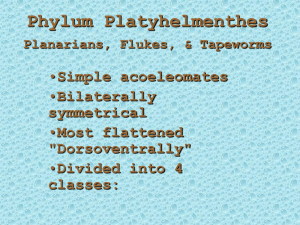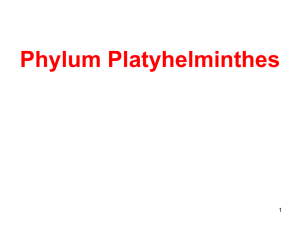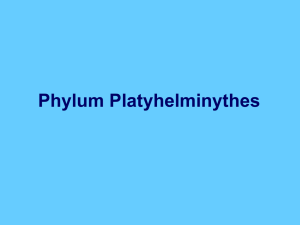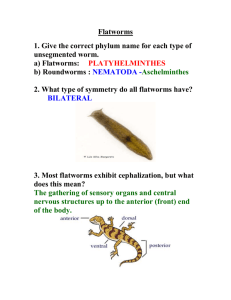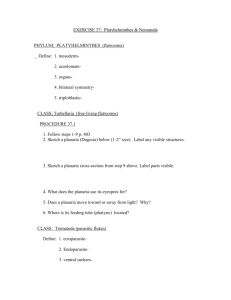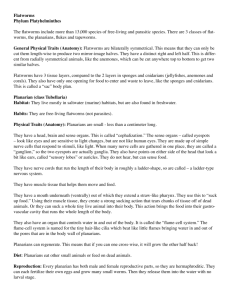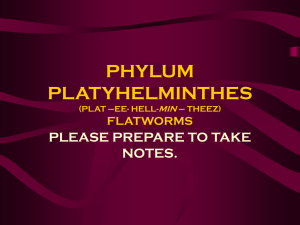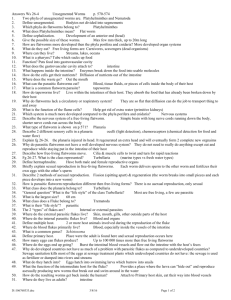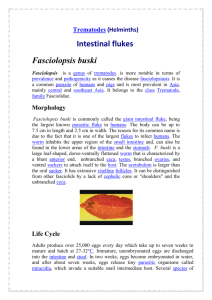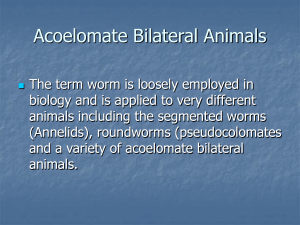Unit 4.1 Phylum Platyhelminthes - Jutzi
advertisement
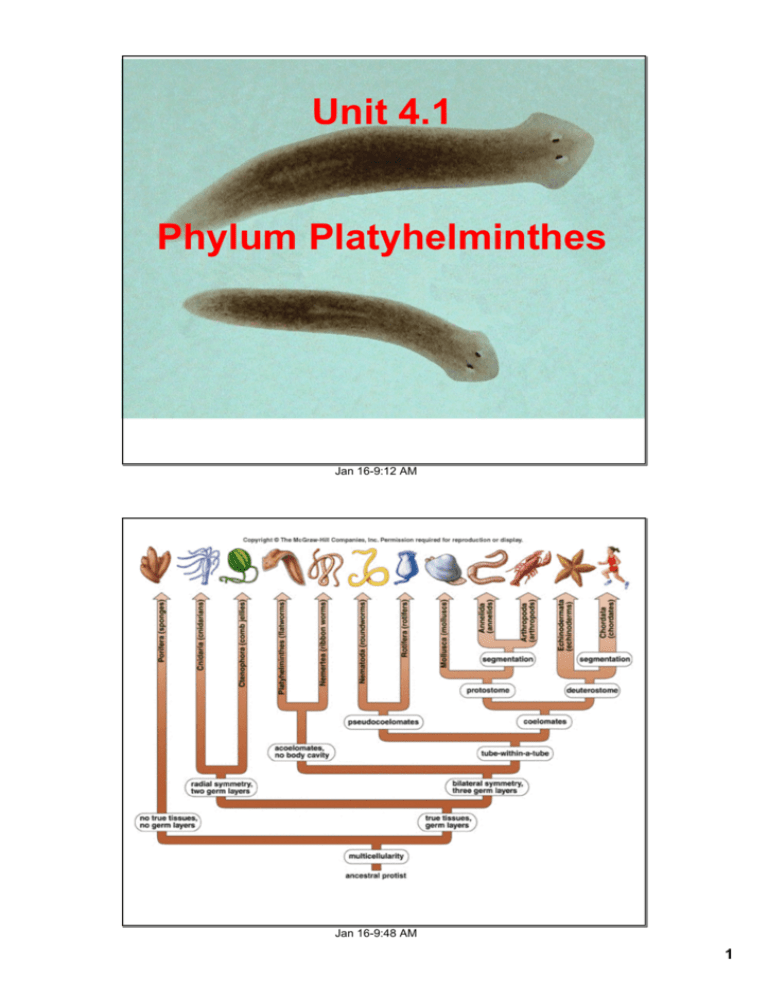
Unit 4.1 Phylum Platyhelminthes Jan 16­9:12 AM Jan 16­9:48 AM 1 Phylum Platyhelminthes • Flatworms • Triploblastic – 3 primary germ layers • Acoelomate – no body cavity • Bilateral symmetry • Monoecious – Having both sperm and egg producing parts • One opening for digestive system located ventrally. Food is eaten and excreted through the same tube. Jan 16­9:12 AM Phylum Platyhelminthes • Paired lateral nerve cords & cerebral ganglion – very simple brain • Flame cells – specialized “kidney” cells • No specialized circulatory or respiratory systems – must be flat so nutrients & oxygen can diffuse throughout the body Jan 16­9:12 AM 2 Acoelomate Ectoderm Mesoderm Endoderm Coelom – A fluid filled space that is completely surrounded by mesoderm Jan 16­9:12 AM Jan 16­9:12 AM 3 Pseudocoelomate Ectoderm Mesoderm Endoderm Coelom – A fluid filled space that is completely surrounded by mesoderm Jan 16­9:12 AM Coelomate Ectoderm Mesoderm Endoderm Coelom – A fluid filled space that is completely surrounded by mesoderm Jan 16­9:12 AM 4 Nervous System Jan 16­9:12 AM Excretory System Jan 16­9:12 AM 5 Reproductive System Jan 16­9:12 AM Digestive System Jan 16­9:12 AM 6 Jan 16­9:12 AM Class Turbellaria • Planarians • Eye spots – detect simple light gradients • Ciliated skin surface secretes mucous and aids in movement • May be aquatic or terrestrial (terrestrial species are all nocturnal) • Most are free­living – not parasites but predators/scavengers Jan 16­9:12 AM 7 Class Turbellaria • Planarians mate by Penis Fencing (traumatic insemination) • Use double­dagger penises to stab at each other • The first worm to make a successful jab will deposit sperm on the body of the loser • The loser then has to bear the burden of committing resources to the developing offspring Jan 29­3:25 PM Turbellarian Regeneration • Planarians have the ability to regenerate new body parts or to generate an entirely new organism from pieces of themselves Jan 16­9:12 AM 8 Jan 16­9:12 AM Class Trematoda • Flukes • Parasites • Hold­fast devices (suckers) • Complex life cycle • Intermediate host ­Animal with juvenile fluke stage (snail) • Definitive host ­Animal with adult fluke stage Jan 16­9:12 AM 9 Fluke Anatomy Jan 16­9:12 AM Fluke Anatomy Oral sucker Intestine Uterus Yolk gland Ovary Seminal recepticle Testes Jan 16­9:12 AM 10 Generalized Fluke Life Cycle Jan 18­10:53 AM Liver Flukes • Sheep, cattle, & humans are susceptible • Weight loss and abdominal pain are primary symptoms • Eventually leads to liver cirrhosis • Eat vegetation or fish contaminated with metacercariae – small capsules that house the intermediate stage of the fluke. Jan 16­9:12 AM 11 Jan 16­9:12 AM Life Cycle of Liver Flukes Jan 16­9:12 AM 12 Intestinal Flukes • 10 million people infected world­wide • Humans and pigs are susceptible • Hemorrhage and abscesses of small intestine • Weight loss and bloody feces are primary symptoms Jan 16­9:12 AM Life Cycle of Intestinal Flukes Jan 16­9:12 AM 13 Lung Flukes • Carnivores, pigs, rodents, & humans • Secondary intermediate host is a crustacean such as a crab or shrimp • Causes lungs to fill with blood interfering with gas exchange • May be fatal Jan 16­9:12 AM Life Cycle of the Lung Fluke Jan 16­9:12 AM 14 Jan 16­9:12 AM Blood Flukes • Parasitize mesenteric blood vessels • Estimated 200 million people infected world­wide • 1 million deaths/year • Second most deadly parasite behind malaria • Dioecious (rare for flatworms) • Males wrap around females & they exist in pairs throughout adult lives Jan 16­9:12 AM 15 Blood Flukes • The eggs all have a hook that tears bodily tissues throughout the human host causing more damage as they are passed • Larvae have a forked tail that assist them in borrowing through human skin Jan 16­9:12 AM Life Cycle of a Blood Fluke Jan 16­9:12 AM 16 Male or Female? Jan 16­9:12 AM Swimmers Itch – Related to Blood Fluke Jan 16­9:12 AM 17 Swimmers Itch • Need avian hosts to complete their life cycle • Humans are “accidentally” infected and develop a rash for around a week • Sores develop around burrowing sites but the larvae die within a few hours of entering the skin Jan 16­9:12 AM Class Cestoidea • Tapeworms • No digestive system – suck in pre­digested nutrients from the intestines of the host that are directly utilized in metabolic processes • Can grow up to 100 feet long (Human tapeworms may reach 60 feet in length) Jan 16­9:12 AM 18 Class Cestoidea • Tapeworm bodies are divided into two main sections • The scolex (head) is equipped with suckers designed to anchor the worm to the intestinal wall and to suck in nutrients • The proglottids are hermaphroditic segments, each able to detach from the body and produce eggs Jan 16­9:12 AM Class Cestoidea • Infections are usually asymptomatic other than lethargy and/or dull abdominal pain • The lethargy is due to a lack of nutrients caused by the tapeworms’ feeding. This leads to weight loss • People may purposefully infect themselves with tapeworms to lose weight Jan 16­9:12 AM 19 Scolex Jan 16­9:12 AM Proglottid Testes Uterus Vas deferens Seminal receptacle Ovary Yolk gland Jan 16­9:12 AM 20 Jan 16­9:12 AM Tapeworm Life Cycle Jan 16­9:12 AM 21 Hydatid Disease • A strange tapeworm causes a potentially fatal parasitic disease called hydatid disease • Herbivores, and sometimes humans, become the intermediate hosts after ingesting eggs on vegetation Jan 16­9:12 AM Hydatid Disease • The eggs then hatch into embryos that lodge in tissues and grow into huge cysts containing thousands of tapeworm larvae • When the cysts finally cause the host to die or become easy prey, they are ingested by the scavenger/predator and become adults in their intestinal tracts Jan 16­9:12 AM 22 Life Cycle of Hydatid Disease Jan 16­9:12 AM Jan 18­11:18 AM 23 Phylum Nemertea • Commonly called Ribbon Worms • Usually around 8 inches long, but one species may reach near 180ft long making it the longest animal on earth • Acoelomates & usually hermaphroditic like flatworms • Most are marine, burrowing animals that feed on clams, crustaceans, and annelids • No parasitic species Jan 16­12:10 PM Jan 16­12:23 PM 24 The End Jan 16­9:12 AM 25
